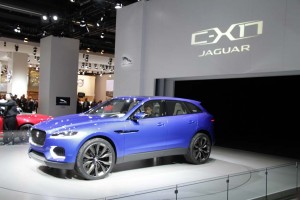
Last year Jaguar revealed the C-X17 concept, which could be the basis for the maker's crossover. However, it could also be the same for Land Rover.
With the upcoming launch of its new XE sedan, Jaguar hopes to re-enter the critical compact car market, but the debut at this month’s Paris Motor Show is significant for a number of other reasons.
The new XE will be the first Jaguar model to use the new Ingenium line of four-cylinder engines. Significantly, the British maker will share those fuel-efficient new powertrains with its sibling brand, Land Rover. Indeed, going forward there will be far more cooperation between the two brands than ever before, including the development of a new “architecture” that will be used as the foundation for a number of new crossover-utility vehicles.
That raises concerns among some observers about whether Jaguar and Land Rover might wind up blurring the lines that separate the two brands in a bid to expand their product ranges while holding down hefty development costs.
Jaguar gave a hint of what’s coming a full year ago with the unveiling of its C-X17 concept crossover at the 2013 Frankfurt Motor Show. The prototype rode on the same platform as the new Jaguar XE sedan and was meant to gauge public reaction to the idea of putting the brand’s iconic logo on the side of a utility vehicle.

The new Jaguar XE is powered by the new Ingenium powertrain, which will likely be shared with Land Rover.
Jaguar has long been reluctant to stray very far from its sports car roots. It spent several decades debating the need for a station wagon – still a popular body style in Europe – before finally adding one a few years ago. More recently, the discussion has turned to crossovers. Compact models have already become the fastest-growing segment in the global luxury market and Jaguar clearly doesn’t want to get left out, so work is progressing rapidly on a production version of the C-X17.
At the same time, Land Rover is moving forward on developing one or more crossovers that will use a variant of the compact Jaguar platform – and, according to insiders, that architecture is likely to be shared with JLR’s Indian parent, Tata Motors, which wants to bring out several new crossovers of its own.
“When – and if – Jaguar does build a crossover,” said Phil Popham, the group marketing director for Jaguar Land Rover, “it will have the DNA of a Jaguar,” and not look like something from the Land Rover brand.
(New European clean air rules would be “fatal” to automakers. For more, Click Here.)
Stressing that Jaguar is a “performance brand,” Popham said the emphasis will be on a “seductive” design and driving dynamics tuned to on-road performance.
Any Land Rover variants will have far more competence in off-road situations, stressed JLR CEO Ralf Speth. “It will be a credible SUV,” which means, among other things, far more wheel articulation to be able to handle the boulder-strewn fields that a Land Rover model is traditionally designed to traverse.
(Click Here for details on GM’s recall of 524,000 vehicles.)
“You would wind up with two very different products,” echoed Popham.
But he admitted the likelihood is high. “This is a segment that can’t be ignored by anyone. You (just) have to come up with a product that’s true to the brand.”
(To see more about Mercedes new Porsche-fighting AMG GT, Click Here.)
Sharing platforms for cars and crossovers has become increasingly common. The new Mercedes-Benz GLA, for example, is based on the same, underlying architecture as the German maker’s CLA model. That coupe-like sedan has become one of Mercedes’ biggest hits ever, but company officials noted last month that the GLA will target a segment of the market that could soon be three times as large.
Details of Tata’s CUV plans haven’t been revealed, but the Indian brand would also like to start sharing more with Jaguar and Land Rover going forward. But how far that can go is uncertain. At least for now, Tata continues to focus on the emerging Indian automotive market best personified by its little Nano model, which costs only a few thousand dollars. Whether it can leverage its JLR alliance and move up-market remains to be seen.
